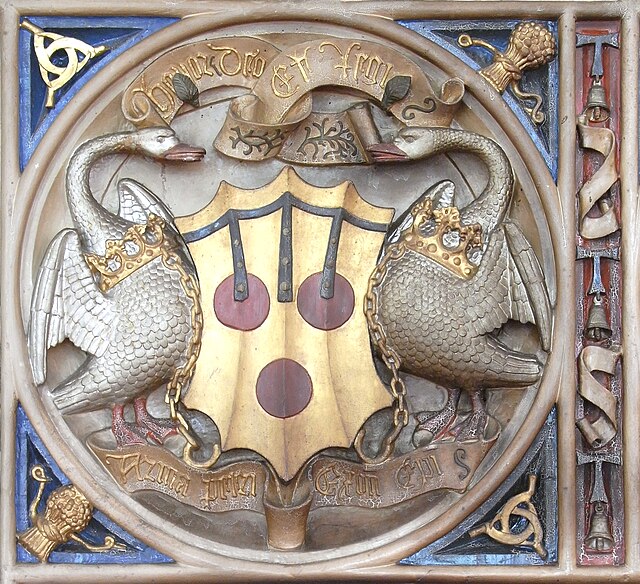The Bohun swan, also known as the Bucks Swan, was a heraldic badge used originally in England by the mediaeval noble family of de Bohun, Earls of Hereford, and Earls of Essex.
Counter seal of Humphrey de Bohun, 4th Earl of Hereford (1276–1322), attached to the Barons' Letter, 1301, showing the Bohun swan above the escutcheon and supporting the guige strap
Bohun swans collared and chained with necks entwined at feet of effigy of Margaret de Bohun (1311–1391), daughter of Humphrey de Bohun, 4th Earl of Hereford (1276–1322) and wife of Hugh de Courtenay, 2nd Earl of Devon (1303–1377). On her chest tomb in south transept, Exeter Cathedral, heavily restored 19th century
The Dunstable Swan Jewel, circa 1400, British Museum. Possibly given to his supporters by the future King Henry V, who was Prince of Wales from 1399
Arms of Peter Courtenay (d.1492), Bishop of Exeter and Bishop of Winchester: Or, 3 torteaux a label of 3 points azure each point charged with 3 plates in pale with supporters the Bohun swans, each collared with a crown and chained or. Detail from the Courtenay Mantlepiece, Bishop's Palace, Exeter
A heraldic badge, emblem, impresa, device, or personal device worn as a badge indicates allegiance to, or the property of, an individual, family or corporate body. Medieval forms are usually called a livery badge, and also a cognizance. They are para-heraldic, not necessarily using elements from the coat of arms of the person or family they represent, though many do, often taking the crest or supporters. Their use is more flexible than that of arms proper.
The Dunstable Swan Jewel, a livery badge from about 1400 AD, perhaps of Henry V as Prince of Wales. British Museum
The Château de Blois, with the porcupine of Louis XII
Imprese from Jacobus Typotius, Symbola Divina et Humana (Prague, 1601), engraved by Aegidius Sadeler II.
Salamander badge of King Francis I of France, with letter "F", Château de Chambord








